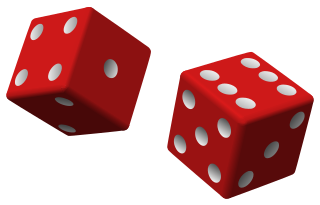A pseudorandom number generator (PRNG), also known as a deterministic random bit generator (DRBG), is an algorithm for generating a sequence of numbers whose properties approximate the properties of sequences of random numbers. The PRNG-generated sequence is not truly random, because it is completely determined by an initial value, called the PRNG's seed. Although sequences that are closer to truly random can be generated using hardware random number generators, pseudorandom number generators are important in practice for their speed in number generation and their reproducibility.

A linear congruential generator (LCG) is an algorithm that yields a sequence of pseudo-randomized numbers calculated with a discontinuous piecewise linear equation. The method represents one of the oldest and best-known pseudorandom number generator algorithms. The theory behind them is relatively easy to understand, and they are easily implemented and fast, especially on computer hardware which can provide modular arithmetic by storage-bit truncation.
A Lagged Fibonacci generator is an example of a pseudorandom number generator. This class of random number generator is aimed at being an improvement on the 'standard' linear congruential generator. These are based on a generalisation of the Fibonacci sequence.
The concept of a random sequence is essential in probability theory and statistics. The concept generally relies on the notion of a sequence of random variables and many statistical discussions begin with the words "let X1,...,Xn be independent random variables...". Yet as D. H. Lehmer stated in 1951: "A random sequence is a vague notion... in which each term is unpredictable to the uninitiated and whose digits pass a certain number of tests traditional with statisticians".

In computing, a hardware random number generator (HRNG), true random number generator (TRNG), non-deterministic random bit generator (NRBG), or physical random number generator is a device that generates random numbers from a physical process capable of producing entropy, unlike the pseudorandom number generator that utilizes a deterministic algorithm and non-physical nondeterministic random bit generators that do not include hardware dedicated to generation of entropy.
A cryptographically secure pseudorandom number generator (CSPRNG) or cryptographic pseudorandom number generator (CPRNG) is a pseudorandom number generator (PRNG) with properties that make it suitable for use in cryptography. It is also loosely known as a cryptographic random number generator (CRNG).
In theoretical computer science and cryptography, a pseudorandom generator (PRG) for a class of statistical tests is a deterministic procedure that maps a random seed to a longer pseudorandom string such that no statistical test in the class can distinguish between the output of the generator and the uniform distribution. The random seed itself is typically a short binary string drawn from the uniform distribution.
A pseudorandom binary sequence (PRBS), pseudorandom binary code or pseudorandom bitstream is a binary sequence that, while generated with a deterministic algorithm, is difficult to predict and exhibits statistical behavior similar to a truly random sequence. PRBS generators are used in telecommunication, such as in analog-to-information conversion, but also in encryption, simulation, correlation technique and time-of-flight spectroscopy. The most common example is the maximum length sequence generated by a (maximal) linear feedback shift register (LFSR). Other examples are Gold sequences, Kasami sequences and JPL sequences, all based on LFSRs.
George Marsaglia was an American mathematician and computer scientist. He is best known for creating the diehard tests, a suite of software for measuring statistical randomness.
A numeric sequence is said to be statistically random when it contains no recognizable patterns or regularities; sequences such as the results of an ideal dice roll or the digits of π exhibit statistical randomness.
A nonlinear-feedback shift register (NLFSR) is a shift register whose input bit is a non-linear function of its previous state.

Random number generation is a process by which, often by means of a random number generator (RNG), a sequence of numbers or symbols that cannot be reasonably predicted better than by random chance is generated. This means that the particular outcome sequence will contain some patterns detectable in hindsight but impossible to foresee. True random number generators can be hardware random-number generators (HRNGs), wherein each generation is a function of the current value of a physical environment's attribute that is constantly changing in a manner that is practically impossible to model. This would be in contrast to so-called "random number generations" done by pseudorandom number generators (PRNGs), which generate numbers that only look random but are in fact pre-determined—these generations can be reproduced simply by knowing the state of the PRNG.
Algorithmic information theory (AIT) is a branch of theoretical computer science that concerns itself with the relationship between computation and information of computably generated objects (as opposed to stochastically generated), such as strings or any other data structure. In other words, it is shown within algorithmic information theory that computational incompressibility "mimics" (except for a constant that only depends on the chosen universal programming language) the relations or inequalities found in information theory. According to Gregory Chaitin, it is "the result of putting Shannon's information theory and Turing's computability theory into a cocktail shaker and shaking vigorously."

Xorshift random number generators, also called shift-register generators, are a class of pseudorandom number generators that were invented by George Marsaglia. They are a subset of linear-feedback shift registers (LFSRs) which allow a particularly efficient implementation in software without the excessive use of sparse polynomials. They generate the next number in their sequence by repeatedly taking the exclusive or of a number with a bit-shifted version of itself. This makes execution extremely efficient on modern computer architectures, but it does not benefit efficiency in a hardware implementation. Like all LFSRs, the parameters have to be chosen very carefully in order to achieve a long period.

In common usage, randomness is the apparent or actual lack of definite pattern or predictability in information. A random sequence of events, symbols or steps often has no order and does not follow an intelligible pattern or combination. Individual random events are, by definition, unpredictable, but if there is a known probability distribution, the frequency of different outcomes over repeated events is predictable. For example, when throwing two dice, the outcome of any particular roll is unpredictable, but a sum of 7 will tend to occur twice as often as 4. In this view, randomness is not haphazardness; it is a measure of uncertainty of an outcome. Randomness applies to concepts of chance, probability, and information entropy.
OpenPuff Steganography and Watermarking, sometimes abbreviated OpenPuff or Puff, is a free steganography tool for Microsoft Windows created by Cosimo Oliboni and still maintained as independent software. The program is notable for being the first steganography tool that:
Yongge Wang is a computer science professor at the University of North Carolina at Charlotte specialized in algorithmic complexity and cryptography. He is the inventor of IEEE P1363 cryptographic standards SRP5 and WANG-KE and has contributed to the mathematical theory of algorithmic randomness. He co-authored a paper demonstrating that a recursively enumerable real number is an algorithmically random sequence if and only if it is a Chaitin's constant for some encoding of programs. He also showed the separation of Schnorr randomness from recursive randomness. He also invented a distance based statistical testing technique to improve NIST SP800-22 testing in randomness tests. In cryptographic research, he is known for the invention of the quantum resistant random linear code based encryption scheme RLCE.
KISS (Keep it Simple Stupid) is a family of pseudorandom number generators introduced by George Marsaglia. Starting from 1998 Marsaglia posted on various newsgroups including sci.math, comp.lang.c, comp.lang.fortran and sci.stat.math several versions of the generators. All KISS generators combine three or four independent random number generators with a view to improving the quality of randomness. KISS generators produce 32-bit or 64-bit random integers, from which random floating-point numbers can be constructed if desired. The original 1993 generator is based on the combination of a linear congruential generator and of two linear feedback shift-register generators. It has a period 295, good speed and good statistical properties; however, it fails the LinearComplexity test in the Crush and BigCrush tests of the TestU01 suite. A newer version from 1999 is based on a linear congruential generator, a 3-shift linear feedback shift-register and two multiply-with-carry generators. It is 10–20% slower than the 1993 version but has a larger period 2123 and passes all tests in TestU01. In 2009 Marsaglia presented a version based on 64-bit integers (appropriate for 64-bit processors) which combines a multiply-with-carry generator, a Xorshift generator and a linear congruential generator. It has a period of around 2250 (around 1075).
xoroshiro128+ is a pseudorandom number generator intended as a successor to xorshift+. Instead of perpetuating Marsaglia's tradition of xorshift as a basic operation, xoroshiro128+ uses a shift/rotate-based linear transformation designed by Sebastiano Vigna in collaboration with David Blackman. The result is a significant improvement in speed and statistical quality.